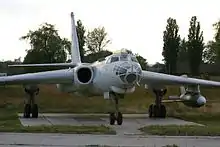Aeroflot Flight 811
Aeroflot Flight 811 was a scheduled Soviet domestic passenger flight from Komsomolsk-on-Amur to Blagoveshchensk that collided mid-air on 24 August 1981 with a Tupolev Tu-16K strategic bomber over Zavitinsky District in Amur Oblast, Russian SFSR, Soviet Union (now Russia). The collision between Aeroflot's Antonov An-24RV and Tupolev Tu-16K occurred at an altitude of 5,220 metres (17,130 ft), killing 37 people on both aircraft. The sole survivor, 20-year-old passenger Larisa Savitskaya from Antonov An-24RV, was rescued on the third day after the accident.
| Accident | |
|---|---|
| Date | 24 August 1981 |
| Summary | Mid-air collision |
| Site | 70 km (43.8 mls) E of Zavitinsk, Russian SFSR, Soviet Union (now Russia) 50°01′10″N 130°28′00″E |
| Total fatalities | 37 |
| Total injuries | 1 |
| Total survivors | 1 |
| First aircraft | |
 An Aeroflot An-24RV similar to the accident aircraft | |
| Type | Antonov An-24RV |
| Operator | Aeroflot |
| Registration | CCCP-46653 |
| Flight origin | Yuzhno-Sakhalinsk Airport (UUS) |
| Stopover | Komsomolsk-on-Amur Airport (KXK) |
| Destination | Blagoveshchensk Airport (BQS/UHBB) |
| Passengers | 27 |
| Crew | 5 |
| Fatalities | 31 |
| Injuries | 1 |
| Survivors | 1 |
| Second aircraft | |
 A Tu-16K similar to the accident aircraft | |
| Type | Tupolev Tu-16K |
| Operator | Soviet Air Forces |
| Registration | 07514 (call sign) |
| Flight origin | Zavitinsk air base |
| Destination | Zavitinsk air base |
| Crew | 6 |
| Fatalities | 6 |
| Survivors | 0 |
Background and collision
Antonov An-24RV departed from Komsomolsk-on-Amur at 14:56 local time, after a four-hour delay due to weather conditions. The crew consisted of first pilot Alexander Mirgorodsky, co-pilot Valery Shevelev, navigating officer Fedosy Kryzhanovsky, flight engineer Nikolai Dimitriyev and air hostess Galina Borisova.[1] Among the passengers was one child.[1] Larisa Savitskaya and her husband Vladimir were returning from their honeymoon.
The flight dispatcher was informed that the local airspace would be traversed by military aircraft at an altitudes of 4,200–4,500 metres (13,800–14,800 ft).[1] On the same day, at 16:00 and 16:01 local time two Tupolev Tu-16K left Zavitinsk air base for weather reconnaissance. At 16:21 local time one of them (serial number 6203106) collided with the Aeroflot An-24RV, 70 km east of Zavitinsk air base.[1] The collision occurred in good lighting conditions, with a visibility of over 10 km.[1] Savitskaya was sound asleep at that moment.[2] The Tu-16K razed off the An-24RV's roof and severed both wings.[2] The temperature inside An-24RV's cabin dropped from 25 °C (77 °F) to −30 °C (−22 °F).[3] Both aircraft disintegrated and fell on taiga terrain. The fragments of Antonov An-24RV were scattered in a south-western direction, 1020 m from the collision point, on a 2500х900 m area. The Tu-16K exploded after the ground impact, its fragments were scattered approximately 2000 m from the collision point.[1]
Savitskaya was conscious during the fall, which lasted eight minutes.[2] She survived partly because the 4х3 m aircraft fragment she was in started to glide[3] and landed on a soft, swampy glade. Savitskaya also pushed against the seat with her hands and feet, "perhaps hoping to absorb the blow" in her own words.[2] The impact with the ground, however, knocked her temporarily unconscious.[2] She sustained a concussion, a broken arm and rib and some spinal injuries.[2]
Investigation
The investigation concluded that the flight operations director at Zavitinsk air base did not use radar assistance to track the Tupolevs, which became the direct cause of the accident.[1] Additionally, there was a poor coordination between the local civilian and military air traffic control due to flawed air traffic regulations.[1] Military prosecutors placed the responsibility for the accident on the pilots of both aircraft.[2]
Aftermath
The first reports about the accident in the Soviet press were censored, saying Savitskaya had crashed in a homemade glider.[2] Savitskaya was warned by the KGB not to reveal the accident to the public; she spoke openly about the accident for the first time on 11 January 2001 in Moscow.[4] Savitskaya was paid 75 Soviet rubles ($20) compensation by Aeroflot.[4]
References
- "Столкновение Ан-24РВ Дальневосточного УГА и Ту-16К в районе Завитинска" (in Russian). Airdisaster.ru. Retrieved 24 January 2014.
- Lyuba Pronina (7 August 2002). "Trapped in a Harrowing Midair Collision". The Moscow Times. Retrieved 24 January 2014.
- "Лариса САВИЦКАЯ: "Для меня уже вырыли могилу"". Izvestia (in Russian). 29 July 2002. Retrieved 24 January 2014.
- "Sole Survivor of 1981 Soviet Plane Collision Speaks". Getty Images. Retrieved 24 January 2014.